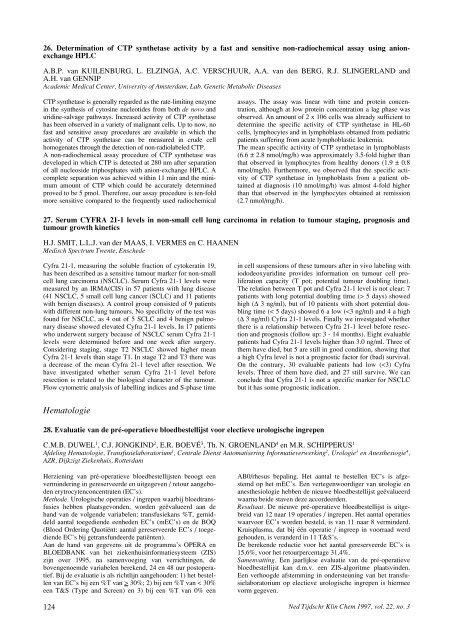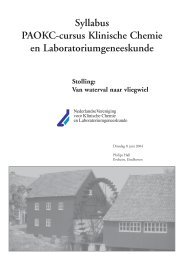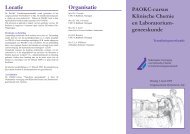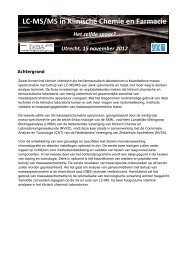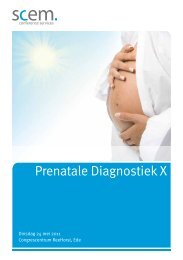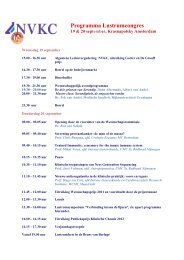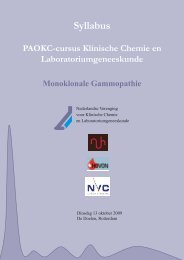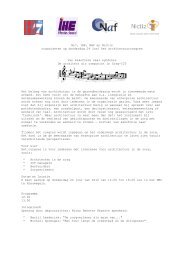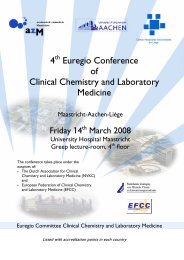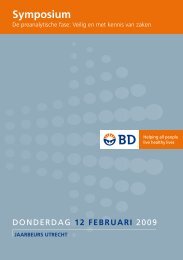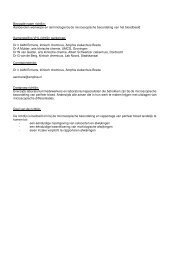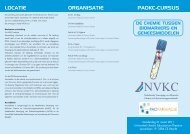Klinische (bio)chemie en methodologie - NVKC
Klinische (bio)chemie en methodologie - NVKC
Klinische (bio)chemie en methodologie - NVKC
You also want an ePaper? Increase the reach of your titles
YUMPU automatically turns print PDFs into web optimized ePapers that Google loves.
26. Determination of CTP synthetase activity by a fast and s<strong>en</strong>sitive non-radiochemical assay using anionexchange<br />
HPLC<br />
A.B.P. van KUILENBURG, L. ELZINGA, A.C. VERSCHUUR, A.A. van d<strong>en</strong> BERG, R.J. SLINGERLAND and<br />
A.H. van GENNIP<br />
Academic Medical C<strong>en</strong>ter, University of Amsterdam, Lab. G<strong>en</strong>etic Metabolic Diseases<br />
CTP synthetase is g<strong>en</strong>erally regarded as the rate-limiting <strong>en</strong>zyme<br />
in the synthesis of cytosine nucleotides from both de novo and<br />
uridine-salvage pathways. Increased activity of CTP synthetase<br />
has be<strong>en</strong> observed in a variety of malignant cells. Up to now, no<br />
fast and s<strong>en</strong>sitive assay procedures are available in which the<br />
activity of CTP synthetase can be measured in crude cell<br />
homog<strong>en</strong>ates through the detection of non-radiolabeled CTP.<br />
A non-radiochemical assay procedure of CTP synthetase was<br />
developed in which CTP is detected at 280 nm after separation<br />
of all nucleoside triphosphates with anion-exchange HPLC. A<br />
complete separation was achieved within 11 min and the minimum<br />
amount of CTP which could be accurately determined<br />
proved to be 5 pmol. Therefore, our assay procedure is t<strong>en</strong>-fold<br />
more s<strong>en</strong>sitive compared to the frequ<strong>en</strong>tly used radiochemical<br />
27. Serum CYFRA 21-1 levels in non-small cell lung carcinoma in relation to tumour staging, prognosis and<br />
tumour growth kinetics<br />
H.J. SMIT, L.L.J. van der MAAS, I. VERMES <strong>en</strong> C. HAANEN<br />
Medisch Spectrum Tw<strong>en</strong>te, Enschede<br />
Cyfra 21-1, measuring the soluble fraction of cytokeratin 19,<br />
has be<strong>en</strong> described as a s<strong>en</strong>sitive tumour marker for non-small<br />
cell lung carcinoma (NSCLC). Serum Cyfra 21-1 levels were<br />
measured by an IRMA(CIS) in 57 pati<strong>en</strong>ts with lung disease<br />
(41 NSCLC, 5 small cell lung cancer (SCLC) and 11 pati<strong>en</strong>ts<br />
with b<strong>en</strong>ign diseases). A control group consisted of 9 pati<strong>en</strong>ts<br />
with differ<strong>en</strong>t non-lung tumours. No specificity of the test was<br />
found for NSCLC, as 4 out of 5 SCLC and 4 b<strong>en</strong>ign pulmonary<br />
disease showed elevated Cyfra 21-1 levels. In 17 pati<strong>en</strong>ts<br />
who underw<strong>en</strong>t surgery because of NSCLC serum Cyfra 21-1<br />
levels were determined before and one week after surgery.<br />
Considering staging, stage T2 NSCLC showed higher mean<br />
Cyfra 21-1 levels than stage T1. In stage T2 and T3 there was<br />
a decrease of the mean Cyfra 21-1 level after resection. We<br />
have investigated whether serum Cyfra 21-1 level before<br />
resection is related to the <strong>bio</strong>logical character of the tumour.<br />
Flow cytometric analysis of labelling indices and S-phase time<br />
Hematologie<br />
Herzi<strong>en</strong>ing van pré-operatieve bloedbestellijst<strong>en</strong> beoogt e<strong>en</strong><br />
vermindering in gereserveerde <strong>en</strong> uitgegev<strong>en</strong> / retour aangebod<strong>en</strong><br />
erytrocyt<strong>en</strong>conc<strong>en</strong>trat<strong>en</strong> (EC’s).<br />
Methode. Urologische operaties / ingrep<strong>en</strong> waarbij bloedtransfusies<br />
hebb<strong>en</strong> plaatsgevond<strong>en</strong>, word<strong>en</strong> geëvalueerd aan de<br />
hand van de volg<strong>en</strong>de variabel<strong>en</strong>: transfusiekans %T, gemiddeld<br />
aantal toegedi<strong>en</strong>de e<strong>en</strong>hed<strong>en</strong> EC’s (mEC’s) <strong>en</strong> de BOQ<br />
(Blood Ordering Quotiënt: aantal gereserveerde EC’s / toegedi<strong>en</strong>de<br />
EC’s bij getransfundeerde patiënt<strong>en</strong>).<br />
Aan de hand van gegev<strong>en</strong>s uit de programma’s OPERA <strong>en</strong><br />
BLOEDBANK van het ziek<strong>en</strong>huisinformatiesysteem (ZIS)<br />
zijn over 1995, na sam<strong>en</strong>voeging van verrichting<strong>en</strong>, de<br />
bov<strong>en</strong>g<strong>en</strong>oemde variabel<strong>en</strong> berek<strong>en</strong>d, 24 <strong>en</strong> 48 uur postoperatief.<br />
Bij de evaluatie is als richtlijn aangehoud<strong>en</strong>: 1) het bestell<strong>en</strong><br />
van EC’s bij e<strong>en</strong> %T van > 30%; 2) bij e<strong>en</strong> %T van < 30%<br />
e<strong>en</strong> T&S (Type and Scre<strong>en</strong>) <strong>en</strong> 3) bij e<strong>en</strong> %T van 0% e<strong>en</strong><br />
assays. The assay was linear with time and protein conc<strong>en</strong>tration,<br />
although at low protein conc<strong>en</strong>tration a lag phase was<br />
observed. An amount of 2 x 106 cells was already suffici<strong>en</strong>t to<br />
determine the specific activity of CTP synthetase in HL-60<br />
cells, lymphocytes and in lymphoblasts obtained from pediatric<br />
pati<strong>en</strong>ts suffering from acute lymphoblastic leukemia.<br />
The mean specific activity of CTP synthetase in lymphoblasts<br />
(6.6 ± 2.8 nmol/mg/h) was approximately 3.5-fold higher than<br />
that observed in lymphocytes from healthy donors (1.9 ± 0.8<br />
nmol/mg/h). Furthermore, we observed that the specific activity<br />
of CTP synthetase in lymphoblasts from a pati<strong>en</strong>t obtained<br />
at diagnosis (10 nmol/mg/h) was almost 4-fold higher<br />
than that observed in the lymphocytes obtained at remission<br />
(2.7 nmol/mg/h).<br />
in cell susp<strong>en</strong>sions of these tumours after in vivo labeling with<br />
iododeoxyuridine provides information on tumour cell proliferation<br />
capacity (T pot; pot<strong>en</strong>tial tumour doubling time).<br />
The relation betwe<strong>en</strong> T pot and Cyfra 21-1 level is not clear: 7<br />
pati<strong>en</strong>ts with long pot<strong>en</strong>tial doubling time (> 5 days) showed<br />
high (∆ 3 ng/ml), but of 10 pati<strong>en</strong>ts with short pot<strong>en</strong>tial doubling<br />
time (< 5 days) showed 6 a low (


